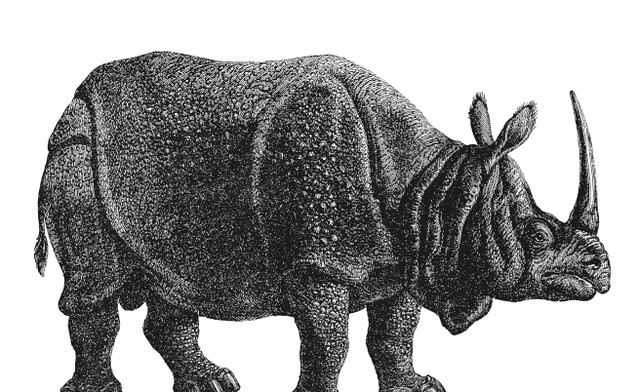The Indian rhinoceros (Rhinoceros unicornis), also called the greater one-horned rhinoceros and Indian one-horned rhinoceros, belongs to the family Rhinocerotidae. Listed as a vulnerable species, the large mammal is primarily found in north-eastern India‘s Assam and in protected areas in the Terai of Nepal, where populations are confined to the riverine grasslands in the foothills of the Himalayas.[2]
The Indian rhinoceros once ranged throughout the entire stretch of the Indo-Gangetic Plain, but excessive hunting reduced their range drastically. Today, more than 3,000 rhinos live in the wild.[3] In 2014, 2,544 of which are found in India’s Assam alone, an increase by 27 percent since 2006, although in early 1900s, Assam had about 200 rhino only.[4]
It is the fifth largest land animal.
The Indian rhinoceros has a thick grey-brown skin with pinkish skin folds and a black horn. Its upper legs and shoulders are covered in wart-like bumps. It has very little body hair, aside from eyelashes, ear fringes and tail brush. Males have huge neck folds. Its skull is heavy with a basal length above 60 cm (24 in) and an occiput above 19 cm (7.5 in). Its nasal horn is slightly back-curved with a base of about 18.5 cm (7.3 in) by 12 cm (4.7 in) that rapidly narrows until a smooth, even stem part begins about 55 mm (2.2 in) above base. In captive animals, the horn is frequently worn down to a thick knob. [5]
The rhino’s single horn is present in both males and females, but not on newborn young. The black horn is purekeratin, like human fingernails, and starts to show after about six years. In most adults, the horn reaches a length of about 25 cm (9.8 in), but has been recorded up to 57.2 cm (22.5 in) in length.[6]
Among terrestrial land mammals native to Asia, the Indian rhinoceros is second in size only to the Asian elephant. It is also the second-largest living rhinoceros, behind only the white rhinoceros. Males have an average head and body length of 368–380 cm (12.07–12.47 ft) with a shoulder height of 170–186 cm (5.58–6.10 ft), while females have an average head and body length of 310–340 cm (10.2–11.2 ft) and a shoulder height of 148–173 cm (4.86–5.68 ft). The male, averaging 2,200 kg (4,900 lb) is heavier than the female, at an average of 1,600 kg (3,500 lb).[7]
The largest sized specimens range up to 4,000 kg (8,800 lb).[8]
(From Wikipedia, February 2015)




